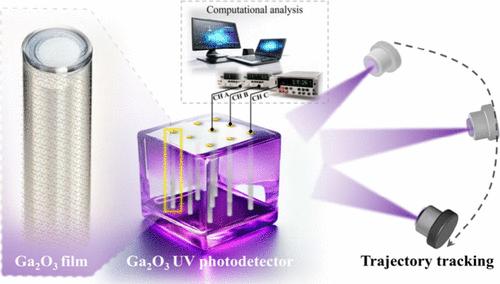Ultrathin Ga2O3 Photodetector with Fast Response and Trajectory Tracking Capability Fabricated by Liquid Metal Oxidation
IF 11.3
1区 化学
Q1 CHEMISTRY, PHYSICAL
引用次数: 0
Abstract
Low-dimensional Ga2O3 demonstrates a unique ultraviolet photoresponse and could be used in various electronic and optical systems. However, the low-dimensional Ga2O3 photodetector is faced with the challenges of a complex preparation process and poor device performance. In this work, ultrathin Ga2O3 layers with ∼7 nm thickness are prepared on quartz rods by UV exposure to liquid gallium. Benefiting from low-density oxygen vacancy defects cured by UV exposure, the low-dimensional Ga2O3 photodetector exhibits a high response speed (rise: 64.7 μs; fall: 51.4 μs) and an exceptional linear dynamic range of 120 dB. Furthermore, the photodetector array based on these ultrathin Ga2O3 shows an effective trajectory tracking capability by monitoring UV source motion. This work develops a simple preparation method to construct a low-dimensional UV photodetector array with fast response and useful trajectory tracking capability, exhibiting the significance of ultrathin Ga2O3 in UV optoelectronics.

通过液态金属氧化法制造出具有快速响应和轨迹跟踪能力的超薄 Ga2O3 光电探测器
低维 Ga2O3 具有独特的紫外光响应,可用于各种电子和光学系统。然而,低维 Ga2O3 光探测器面临着制备工艺复杂、器件性能差等挑战。在这项工作中,通过将液态镓置于紫外光下,在石英棒上制备了厚度为 7 纳米的超薄 Ga2O3 层。得益于紫外线照射固化的低密度氧空位缺陷,低维 Ga2O3 光电探测器表现出较高的响应速度(上升:64.7 μs;下降:51.4 μs)和 120 dB 的优异线性动态范围。此外,基于这些超薄 Ga2O3 的光电探测器阵列通过监测紫外光源的运动,显示出有效的轨迹跟踪能力。这项研究开发了一种简单的制备方法来构建具有快速响应和有效轨迹跟踪能力的低维紫外光探测器阵列,展示了超薄 Ga2O3 在紫外光电子学中的重要作用。
本文章由计算机程序翻译,如有差异,请以英文原文为准。
求助全文
约1分钟内获得全文
求助全文
来源期刊

ACS Catalysis
CHEMISTRY, PHYSICAL-
CiteScore
20.80
自引率
6.20%
发文量
1253
审稿时长
1.5 months
期刊介绍:
ACS Catalysis is an esteemed journal that publishes original research in the fields of heterogeneous catalysis, molecular catalysis, and biocatalysis. It offers broad coverage across diverse areas such as life sciences, organometallics and synthesis, photochemistry and electrochemistry, drug discovery and synthesis, materials science, environmental protection, polymer discovery and synthesis, and energy and fuels.
The scope of the journal is to showcase innovative work in various aspects of catalysis. This includes new reactions and novel synthetic approaches utilizing known catalysts, the discovery or modification of new catalysts, elucidation of catalytic mechanisms through cutting-edge investigations, practical enhancements of existing processes, as well as conceptual advances in the field. Contributions to ACS Catalysis can encompass both experimental and theoretical research focused on catalytic molecules, macromolecules, and materials that exhibit catalytic turnover.
 求助内容:
求助内容: 应助结果提醒方式:
应助结果提醒方式:


